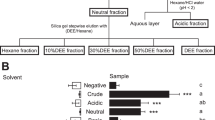Abstract
Methylene chloride-extractable chemical(s) from range caterpillar larval silk facilitates trail-following and aggregation by early-instar larvae, but late-instar larvae are less responsive to the pheromone. Larval aggregation does not reduce water loss when larvae are exposed to low humidity, nor does aggregation prevent predation by the antFormica neoclara Emery. Grouped larvae gain weight and complete early stadia more rapidly as compared to solitary larvae. Aggregation may provide increased visibility to herbivores and increase the impact of urticating spines, thereby decreasing inadvertant predation.
Similar content being viewed by others
References
Ainslie, C.N. 1910. The New Mexico range caterpillar.USDA Bur. Entomol. Bull 85:57–96.
Brown, J.L. 1975. The Evolution of Behavior. Norton, New York, 761 pp.
Butler, C.G. 1970. Chemical communication in insects: Behavioral and ecological aspects.Adv. Chemoreception 1:36–78.
Capinera, J.L. 1978. Studies of host plant preference and suitability exhibited by early-instar range caterpillar larvae.Environ. Entomol. 7:738–40.
Fitzgerald, T.D. 1976. Trail marking by larvae of the eastern tent caterpillar.Science 194:961–963.
Fitzgerald, T.D., andGallagher, E.M. 1976. A chemical trail factor from the silk of eastern tent caterpillarMalacosoma americanum (Lepidoptera: Lasiocampidae).J. Chem. Ecol. 2:187–193.
Ghent, A.W. 1960. A Study of the group-feeding behavior of larvae of the Jack Pine Sawfly,Neodiprion pratti banksianae Roh.Behavior 16:110–148.
Huddleston, E.W., Dressel., E.M., andWatts, J.G. 1976. Economic threshold for range caterpillar larvae on blue grama pasture in northeastern Lincoln County, New Mexico, in 1975.N.M. Agric. Exp. Stn. Res. Rep. 314:1–4.
Matthews, R.W., andMatthews, J.R. 1978. Insect Behavior. Wiley, New York. 507 pp.
Mcmanus, M.L., andSmith, H.R. 1972. Importance of the silk trails in the diel behavior of late instars of the gypsy moth.Environ. Entomol. 1:793–795.
Rohlf, F.J., andSokal, R.R. 1969. Statistical Tables. Freeman, San Francisco. 253 pp.
Rust, M.K., andReierson, D.A., 1977. Increasing blatticidal efficacy with aggregation pheromone.J. Econ. Entomol. 70:693–696.
Singh, P. 1977. Artificial Diets for insects, Mites, and Spiders. IFI/Plenum Data Co., New York. 594 pp.
Teale, E. W. 1949. The Insect World of J. Henri Fabre. Dodd, Mead, and Co., New York. 333 pp.
Watts, J. G., andEverett, T. D. 1976. Biology and behavior of the range caterpillar.N. M. Agric. Exp. Stn. Bull. 646:1–32.
Wellington, W.G. 1957. Individual differences as a factor in population dynamics: The development of a problem.Can. J. Zool. 35:293–323.
Wildermuth, V.L., andCaffrey, D.J. 1916. The New Mexico range caterpillar and its control.USDA Bull. 443:1–12.
Wilson, E.O. 1971. The Insect Societies. Belknap Press, Cambridge, Massachusetts. 548 pp.
Author information
Authors and Affiliations
Rights and permissions
About this article
Cite this article
Capinera, J.L. A trail pheromone from silk produced by larvae of the range caterpillarHemileuca oliviae (Lepidoptera: Saturniidae) and observations on aggregation behavior. J Chem Ecol 6, 655–664 (1980). https://doi.org/10.1007/BF00987676
Received:
Revised:
Issue Date:
DOI: https://doi.org/10.1007/BF00987676




